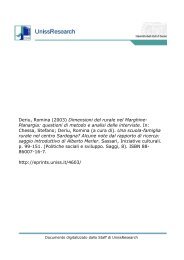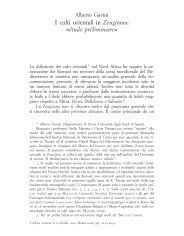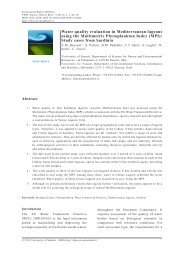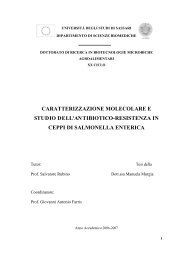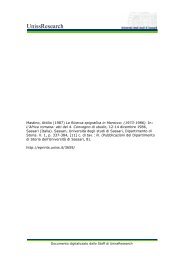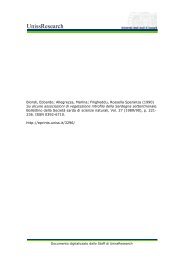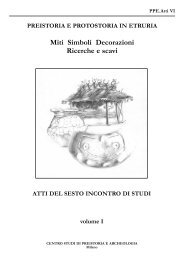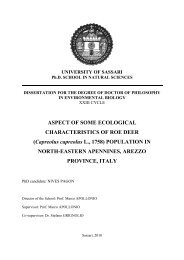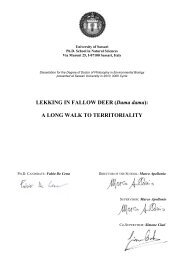- Page 1 and 2:
UnissResearch Mastino, Attilio a cu
- Page 3 and 4:
Pubblicazioni del Dipartimento di S
- Page 5 and 6:
Questo volume è stato stampato per
- Page 7 and 8:
6 Jean-Michel Roddaz au cours des p
- Page 9 and 10:
lO Giancarlo Susini scersi e unific
- Page 13 and 14:
16 Lidiano Bacchielli - Lidio Gaspe
- Page 15:
18 Calendario dei lavori Intervento
- Page 18 and 19:
24 Calendario dei lavori l'Assessor
- Page 20 and 21:
28 Elenco dei partecipanti Alberto
- Page 22 and 23:
32 Elenco dei partecipanti Donatell
- Page 24 and 25:
34 Attilio Mastino gionale Superior
- Page 26:
Saluto del prof. Giovanni Palmieri
- Page 29 and 30: 44 Mario Manca Spero quindi che la
- Page 31: 48 Giovanni Drizzi COSÌ, malgrado
- Page 34 and 35: 54 René Rebuffat que des expressio
- Page 36 and 37: 58 Eugenio Lanzillotta Cirenaica, a
- Page 38 and 39: Azedine Beschaouch L'Africa Romana,
- Page 40: M'hamed Fantar L'épigraphie puniqu
- Page 46 and 47: Tavola II
- Page 48 and 49: Tavola IV
- Page 50: Cinzia Rossignoli Persistenza del c
- Page 62 and 63: 96 Cinzia Rossignoli LÉZINE 1960:
- Page 64 and 65: vola II 1: Mozia, antuario del Capp
- Page 66: """i 2: Monte Sirai, «tempio del m
- Page 69 and 70: J esper Carlsen Dispensatores in Ro
- Page 73 and 74: 104 Jesper Carlsen themselves and s
- Page 76 and 77: 108 Arnaldo Marcone Il discorso si
- Page 82 and 83: 118 Fadel Ali Mohamed - Joyce Reyno
- Page 84 and 85: New inscription no. 1. Photograph b
- Page 87: New inscription no. 4. Photograph b
- Page 90: Mario Luni Strutture monumentali e
- Page 102 and 103: 146 Mario Luni meridionale, situato
- Page 104 and 105: Tavola II Propileo Sud del Ginnasio
- Page 106 and 107: Tavola IV a: Architrave iscritto ri
- Page 108 and 109: Tavola VI a: Frammenti di blocchi i
- Page 110 and 111: Facciata esterna del propileo Est n
- Page 112 and 113: Tavola X a: Trabeazione del propile
- Page 114: Tavola XII a: Blocco iscritto, in o
- Page 124 and 125: Tavola I Frammento di statua coloss
- Page 126 and 127: l: Santuario di Apollo. Braciere di
- Page 129 and 130:
1: Santuario di Apoll.o. Altari nel
- Page 132 and 133:
166 Claudio Parisi Presicce sto, il
- Page 138:
176 Serena Ensoli Vittozzi non diss
- Page 156 and 157:
212 Serena Ensoli Vitlozzi teri di
- Page 159 and 160:
218 Serena Ensoli Vittozzi Indagini
- Page 163:
226 Serena Ensoli Vittozzi di prest
- Page 170:
240 Serena Ensoli Vittozzi La cura
- Page 173 and 174:
246 Serena Ensoli Vittozzi re» che
- Page 175 and 176:
250 Serena Ensoli Vit/ozzi QAL 1987
- Page 177 and 178:
Tavola Il I: Cirene, Santuario di A
- Page 179 and 180:
Tavola IV l: Cireneo Santuario di A
- Page 181 and 182:
Tavola VI l: Cirene, Acropoli, Sant
- Page 183 and 184:
Tavola VIII 1: Cirene, Acropoli, Sa
- Page 185 and 186:
Tavola X 1: Cireneo Rilievo con div
- Page 187 and 188:
Tavola XII l: Cirene, Santuario di
- Page 190 and 191:
2 · Tavola XV !: Cirene, Santuario
- Page 193 and 194:
Tavola XVIII l: Cirene, Acropoli, S
- Page 195 and 196:
Tavola XX 1: Cirene, Acropoli, Sant
- Page 197 and 198:
2: Cirene, Acropoli, Santuario di I
- Page 199 and 200:
Tavola XXIV 1: Cirene, Acropoli, Sa
- Page 201 and 202:
Tavola XXVI Cirene, Acropoli, Santu
- Page 203 and 204:
252 Ahmed M'charek Zama Regia, l'au
- Page 206 and 207:
258 Ahmed M'charek • Principale c
- Page 208 and 209:
Dédicace du tempIe de Tel/us. Tavo
- Page 212 and 213:
264 Ahmed M'charek De toutes façon
- Page 219 and 220:
276 Andreina Magioncalda e si può
- Page 226 and 227:
290 Andreina Magionca/da ADDENDUM S
- Page 229:
294 Zei"neb Ben Abdallah - Habib Be
- Page 233 and 234:
Textel: La dédicace de Thignica. T
- Page 235 and 236:
Inscription du CIL, VIlI n° 15202.
- Page 238:
Samir Aounallah Une nouvelle inscri
- Page 243:
308 Samir Aounallah drien 32 : Diuo
- Page 246:
314 Samir Aounal/ah Romanisation re
- Page 249 and 250:
Tavola I
- Page 251 and 252:
320 Mustapha Khanoussi Fig. 1: Loca
- Page 253 and 254:
324 Mustapha Khanoussi et rare en I
- Page 255 and 256:
Stèle du légionnaire L. Obulcius.
- Page 257 and 258:
Tavola III
- Page 260 and 261:
328 Mustapha Khanoussi prend que ce
- Page 262 and 263:
330 Fathi Bejaoui Les pièces annex
- Page 264 and 265:
334 Fathi Bejaoui près de la bordu
- Page 267 and 268:
Ta ola III l: Le chceur avec au fon
- Page 269 and 270:
n exemple d'une double épitaphe (a
- Page 271 and 272:
L'épitaphe de Bictoricus, exemple
- Page 273 and 274:
Tavola I
- Page 275 and 276:
L'épitaphe de Basilius, «in situ
- Page 277 and 278:
L'épitaphe de Tribunus prètre, ap
- Page 279 and 280:
Ta ola
- Page 281 and 282:
Tavola XVII
- Page 283 and 284:
A propos des mosai"ques funéraires
- Page 285:
Michel Christol I. Bardo, App. 36:
- Page 289 and 290:
Jean-Paul Rey-Coquais Un légat d'A
- Page 292 and 293:
350 Jean-Paul Rey-Coquais suite du
- Page 294 and 295:
Deir el-Qala. Tavola II
- Page 297 and 298:
Francesca Ghedini Gymnasia ... in t
- Page 300 and 301:
358 Francesca Ghedini In realtà, a
- Page 302 and 303:
362 Johannes Irmscher nem perpetuum
- Page 304 and 305:
Introduction Xavier Dupuis - Pierre
- Page 306 and 307:
Tavola I 1: Caisson anépigraphe du
- Page 308 and 309:
I: Inscription des praedia de S.I.P
- Page 310 and 311:
l: Sarcophage anépigraphe (CI. J.
- Page 312 and 313:
Tavola VII o 50 100 150 200 4. Vue
- Page 314 and 315:
Tavola IX l: Inscription de la basi
- Page 316 and 317:
1: Caisson de Valerius Maximus, vue
- Page 318 and 319:
2: Caisson de Domitius Donatus (Cl.
- Page 320:
Une vallée peu connue de l'Aurès
- Page 323:
372 Xavier Dupuis - Pierre Morizot
- Page 332:
390 Jean-Pierre Laporte A) Descript
- Page 338 and 339:
402 Jean-Pierre Laporte non à un c
- Page 343:
412 l" Jean-Pierre Laporte " \ \ Fi
- Page 346:
418 Jean-Pierre Laporte C) Signific
- Page 349 and 350:
N acéra Benseddik Vsinaza (Saneg):
- Page 352 and 353:
430 Nacéra Benseddik Nouum (Aln De
- Page 354 and 355:
434 Nacéra Benseddik gitane. La li
- Page 356:
Tavola I
- Page 360 and 361:
444 René Rebuffat Lixus p. 59 Corr
- Page 363:
450 René Rebuffat ces de la maison
- Page 370 and 371:
464 René Rebuffat 523, 554 - Volub
- Page 375 and 376:
474 René Rebuffat Sulpicius Sasull
- Page 380 and 381:
484 René Rebuffat En 109, sont dé
- Page 386 and 387:
496 René Rebuffat male à cette é
- Page 391 and 392:
l: Rirha, enceinte urbaine, pierres
- Page 393 and 394:
1: Volubilis, IAM 831, rainure du c
- Page 396 and 397:
l: Thamusida, partie inférieure. 2
- Page 398 and 399:
504 Michael Speidel 15 [V]al(erius)
- Page 400 and 401:
SOMMARIO
- Page 402 and 403:
510 Sommario 73 CINZIA ROSSIGNOLl,
- Page 404:
Finito di stampare nel mese di dice



